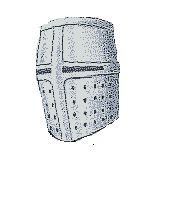|
|
|
 |
 |
| KNIGHTS TEMPLAR IN BALDOCK |
 |
| n about 1142 Gilbert de Clare, Earl of Pembroke, gave about 120 acres of land from his Manor of Weston to the Knights |
| Templars " with ample liberties." Here the Knights built a town which they called 'Baudac.' It has been said that this was a Norman-French form of Baghdad. Salmon, the Hertfordshire historian writing in 1721 says that the name is from 'Bagdet' or 'Baldack' near Babylon, which was in the possession of the Knights Templar until 100 years after the founding of our Baldock. Through the Earl of Pembroke, Baldock received many privileges from the King, including the right of holding fairs and markets, and these privileges were confirmed by charter of William Marshall, Earl of Pembroke, in 1201. In 1199 King John granted to the Templars the right of holding a yearly fair at Baldock on St. Matthew's day and the four days following [September 21-25], and this was confirmed in 1227 by Henry III. Our annual fair, when the High Street is closed to traffic, is now held on October 2-3, the difference in date being caused by the omission of eleven days from the calendar in 1752. In 1492 two fairs were granted to the Knights Hospitallers at Baldock on the Vigil, Feast and morrow of St. James [July 24-26]. Today, all that is left of the Knights Templars' connection with Baldock is the parish church of St. Mary the Virgin, and, more recently, the Knights Templar School in Park Street, on land which, it is claimed, was originally part of the Earl of Pembroke's deer park. The parish church seems at first to have been served by Chaplains of the Order of Knights Templar. In 1308, Edward II seized all the Knights Templar in England and confiscated their property; thus, we get our first written record, of the presentation of Henry de Craystok to the Vicarage of the Church of Baldock in July 1308,"which was in the King's gift by reason of the lands of the Knights Templars being in his hands." After the arrest of the Knights Templars, the church at Baldock was granted to the Knights Hospitallers, who rebuilt the original church of c.1150 in about 1325. However, in the oldest surviving part of the church is a corbel [see below] of a heavily-moustached Knights Templar, complete with chain-mail. Some historians believe that this is a representation of Reginald de Argentein, who is buried in the nave. He was responsible for the building of the original church and his is one of the six Knights Templar graves reportedly in and around the church. Not all can be accounted for. The Argenteins were a Norman family who came over with William the Conqueror in 1066 and were the King's cupbearers until the reign of Henry VI. |
| The 'Templar corbel' at St Mary's church |